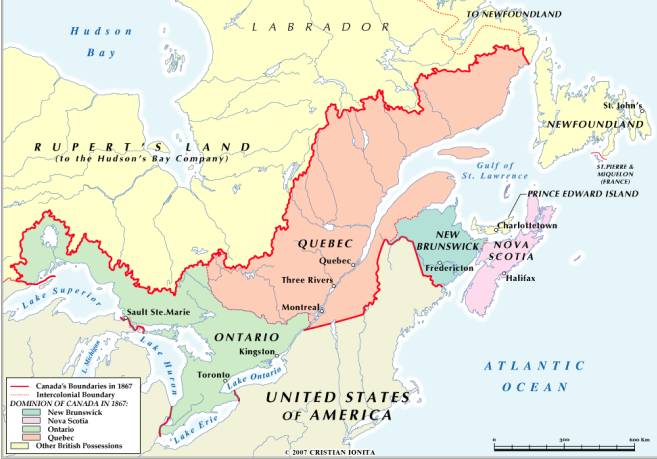As Canada reaches the grand age of 155, it is a good time to look back and see how it all came to pass. As with so many things in Canadian History, the presence and threat of the neighbour to the south was a major factor in bringing the British North American Provinces together to form a new nation.
Confederation of the British North American provinces was not simply an idea in the minds of the politicians of the Province of Canada as the 1860’s dawned. Although the concept had been talked about on and off for a few decades by then, it had never been really pursued seriously. But as a political stalemate took an increasing hold on Canada, relations with the Republic to the south also gained in urgency and importance, and would have a profound influence on the story of Confederation.
From the time when European powers first made claims on North America, there had been a north-south struggle between them. At first, it was France north of the Saint Lawrence facing the Dutch to the south. Then the British took the place of the Dutch and the trading and military rivalry between the two Crowns finally resulted in the conquest of the French territory in 1760. The irony, of course, is that, just twenty years later, the British had lost the Thirteen Colonies and now they were the ones looking south at the noisy neighbours in some alarm.
Twenty years after that, the two were at war again, as the struggle against Napoleon indirectly spilled over in the War of 1812. The Rideau Canal was built in the late 1820’s to provide a safe passage for troops and material in case of another war with the United States. In 1838, Hunters Lodge “patriots” launched an attack at Prescott, using American territory as a base against the British Americans.
The growing economic strength, increase in population, and apparent intention of the Americans to expand across the continent, raised fears within the British Government in London that their North American colonies, particularly Canada, would be the cause of yet another war with the States. The mid-Nineteenth Century in Britain was a time of retrenchment, as the Government sought to cut expenditures and lessen their defense commitments in North America. Canadians, as well as the governments in the other British American provinces, were being urged to take on more responsibility for raising and equipping militia for their own defense, rather than relying on British regular troops.
 Canadians, in particular, resisted those pressures from the Mother Country, believing that any conflict with the U. S. would come, not out of any dispute with them, but as part of a general confrontation between the Americans and the British Empire. Given that, they said, why should Canadians pay for a war the British would start? Sources of conflict certainly existed between the two nations, specifically over the borderline between Maine and New Brunswick, and Quebec and New Hampshire, disputes only ended in 1842 by the Treaty of Washington.
Canadians, in particular, resisted those pressures from the Mother Country, believing that any conflict with the U. S. would come, not out of any dispute with them, but as part of a general confrontation between the Americans and the British Empire. Given that, they said, why should Canadians pay for a war the British would start? Sources of conflict certainly existed between the two nations, specifically over the borderline between Maine and New Brunswick, and Quebec and New Hampshire, disputes only ended in 1842 by the Treaty of Washington.
The shadow of the United States hung over British America, prompting both the local and the Imperial Governments to consider their options. The Imperial government became convinced that they would inevitably be dragged into a war with the U.S. as long as they were so committed to their colonies and especially the defense of Canada. The British Americans, again particularly the Canadians, were well aware of this attitude on the part of the Mother of Parliaments, and began to see the union of British America as the only safeguard against American expansionism. The Americans, for their part, had a strong sense of what they called Manifest Destiny, that is, that they were destined to take over the entire continent, coast to coast.
North and west of Canada were the Hudson’s Bay Company lands, stretching from west of Lake Superior as far as the Rockies, and north to Hudson’s Bay. This consisted of what is today northern Québec and Labrador, northern and western Ontario, all of Manitoba, most of Saskatchewan, south and central Alberta, parts of the Northwest Territories and Nunavut, and small sections of the United States. Both Americans and Upper Canadians cast longing eyes at the vast tract, and it was clear one of the two would move in at some point. 1861 was the year when these issues came together with the deep political problems facing the Canadian Assembly to create the impetus to get people willing to consider new arrangements, new ideas. The 1861 Census revealed that Upper Canada was now under-represented in the Assembly, but Lower Canada was unwilling to adopt Representation by Population. George Brown, firm advocate of Rep by Pop, was determined to win “Justice for Upper Canada”.
But it was the noisy neighbours who really put the cat among the pigeons. In April, 1861, the Federal forces fired on Fort Sumter and the American Civil War began. Things were about to get very dangerous indeed for the province of Canada. Overcoming provincial interests was not easy, and it would take years of talks, men of vision, and the threat of American annexation, or even invasion, to finally bring about the Dominion of Canada in 1867.
